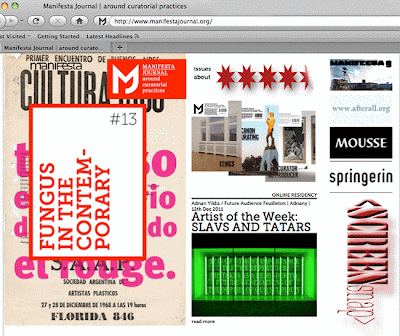Manifesta Journal is pleased to announce the launch of its third series. The format of Manifesta Journal(MJ), like the Manifesta biennial, is a changing model. It aims to facilitate a platform for a critical analyses into international curating and biennials in general. Every six editions, a new editorial team from diverse areas of Europe and beyond is invited to develop a different concept for the series, reflecting on contemporary Europe and the world.
For the first time in MJ's history, MJ #13–18 will be available for free online. Readers will also soon be able to order a print-on-demand issue.
About: Founded in 2003, Manifesta Journal is an international journal that focuses on the practices and theories of contemporary curating. Manifesta Journal is an independent project, initiated by the Manifesta Foundation. The format of Manifesta Journal (MJ), like the Manifesta biennial, is a changing model. It aims to be both self-reflective and critical toward international curating and biennials in general, but also toward its own functional mechanisms. Every six editions, a new editorial team from diverse areas of Europe and beyond is invited to develop a different concept for the series, to reflect on contemporaery Europe and the world ... After the comprehensive grammar and manual for contemporary curatorship established in the first six issues of Manifesta Journal, MJ #1–6, by Viktor Misiano and Igor Zabel and which continued in the series of six issues that were realized between 2009–2011 by Viktor Misiano, Senior Editor Nathalie Zonnenberg and Associate Editor Filipa Ramos, Nataša Petrešin-Bachelez as Chief Editor and Virginie Bobin as Associate Editor have taken over the editorial work of the Manifesta Journal for the upcoming six issues, MJ #13–18. Manifesta Journal can be regarded as a porous platform to reconsider ... read more here
•••

The canon of curating: At the heart of MJ’s 11th issue, “The Canon of Curating,” lies the question on how the canon of curating is to be defined. If “a history of exhibitions” must be written what should its parameters be? In art history, the canon has been losing ground since the 1960s, when the study of “great artists” began to be replaced slowly by the study of the conditions surrounding artistic practice. This shift was also demonstrated by curators of the time. Nevertheless, within the practice of curating, the canon seems to occupy a noteworthy position—if only because some curators still feel the need to “curate outside the canon.” In the Historiography section, Bruce Altshuler explores the discussion and research around the complex establishment of an exhibition canon. Simon Sheikh notes in his contribution that it is important to keep the inclusionary and exclusionary mechanisms of a canon in mind and reconsider the .... read more here
•••

Ethics “The true art of a curator is an art of compromise.” No doubt Pierre Restany's bon mot reflects the reality of curatorial practice. Curators are dealing with different and often alien interests—political, economic and social. In realizing their oeuvre, they must always satisfy the requests of politicians, sponsors, managers, artists, professionals and large audiences. What are the limitations of this art of compromise? Does an art of compromise also presume a consciousness of what should not be a matter of compromise? These are among the many questions that lay at the ground of Manifesta Journal 12 on curatorial ethics; these questions ultimately also try to examine whether ethics is a secondary consideration for curatorial work, or inextricable from the process and ..... read more here


No comments:
Post a Comment